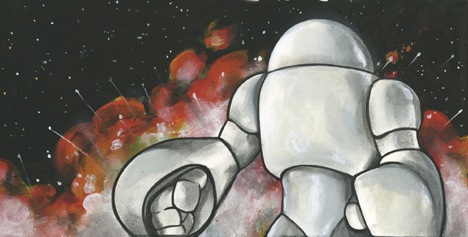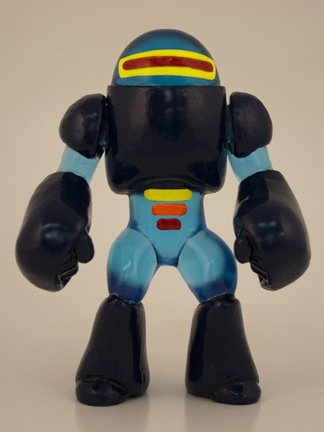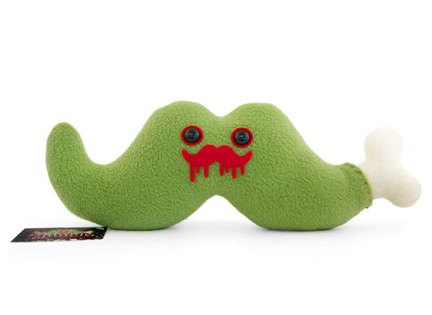Toy Story (original) (raw)
Feature Tue Nov 30 2010
This article was submitted by Michael Moreci
It's the mid-nineteenth century, Normandy, France. Claude Monet is still just a young boy with dreams of being a singer when one day, he happens upon a swirling cluster of water lilies. Maybe he doesn't realize it then, but the moment marks him in an indelible way.
Jump 130 years later. Ben Spencer is an average American kid, growing up on a steady diet of cartoons and action figures. He, too, doesn't realize the impression that will inspire him years down the road, how He-Man, Thundercats, and Go-Bots are shaping his sensibilities.
The point here is that, at times, part of the enigmatic process of creating art is a reflection of the culture one grows up in. Claude Monet grew up to create a series of water lily paintings; Ben Spencer just recently designed his first toy, Galaxxor, a figure that blends Spencer's love of early-80s toys with his own design aesthetics. Yet the gap between the two sensibilities-French Impressionism and toy design--and how they are perceived as art couldn't be wider.

Galaxxor, for example, is a mixture of unique aesthetics. It's this kind of artistic consideration that often gets overlooked in toy design. Like comic books and video games, toys are categorized as child-play things, cast aside to be enjoyed in specialty stores and traveling conventions, rather than thoughtful reflections of contemporary culture.
"In the case of toys, something becomes a piece of art when the creator (or creators) is trying to have some sort of dialogue with the viewer through the piece that they have created," Spencer said. "In terms of the Galaxxor project, I am aiming to make something that, through a network of visual references, celebrates what I love about the aesthetics of various elements of nerdy culture. I figure that if someone wants to really investigate the origins of the various design elements of the Galaxxor figures, that's sort of like a new way to 'play' with the toy."
Just as Spencer was completing college as a graphic design major, it dawned on him that his sensibilities were oftentimes inspired by a specific source--Masters of the Universe figures. That line of early '80s He-Man figures was a big part of Spencer's childhood, but his fondness for them is more about design and less about nostalgia. The interaction of shapes and the dynamics of those figures can be seen all over Spencer's Galaxxor figure.

Galaxxor
"I certainly had another epiphany along those lines when I first encountered Rotofugi," Spencer said. "This was actually the first time I realized that people all around the world were making toys that were being evaluated in the same way that we look at art. These ranged from Japanese monster vinyl toys, or Kaiju, that were fetishized and elevated to art status simply because of the beauty of their design to pieces created by well-known Low Brow artists that were toys in an almost ironic sense. It is my intention with a project like Galaxxor to create a sort of love letter to the more stylish corners of geek culture, filtered through what I have come to know of the modern art toy scene."
Spencer is by no means alone in his embracing of pop cultural icons, specifically toys, and allowing them to actively influence his work. In fact, Chicago's toy scene has evolved into a thriving pocket of the city's "geek culture," alongside comics, crafts, and other creative niches. (It's no coincidence that Spencer co-hosts Nerd City, a weekly podcast, alongside writer/comedian Max Minor). Shawn Smith, creative director and founder of the character design studio Shawnimals, also sees toys as pieces of art, but not just on the merit of being a toy.
"Intentionality is key. If you set out to make an art toy, then there's a hell of a better chance of it actually being that in the end," Smith said. "I say better chance, because while intent is a huge part of it, there's also what the end product actually is, however well-intentioned the artist was. Sometimes it's simply a really nice product. Artful, perhaps, but a product."
Like Spencer, Smith finds inspiration for his designs in pop cultural learnings that stem back to his childhood.
"The same inspiration I had back then--cartoons, comics, video games, and pop culture at large--still informs what I do now," Smith said. "I love designing characters and personifying inanimate objects. Scribbles in the margins of my old notebooks and random creatures from my sketchbooks formed the basis of Shawnimals way back in 2001. From those humble, 2D beginnings, crude and yet endearing handmade plush toys were created."

Shawnimals' wildly popular, handmade "Zombie Stache" plush toy
A big part of what keeps Chicago so explosive in the designer toy biz comes not from the creators alone--there are the retailers as well, most notably Rotofugi and Oh No! Doom, both of which combine toy stores with art galleries. It's their presence, along with other creators, that have helped enable Spencer to make his toy ambitions a reality.
"I am exceptionally lucky in the sense that I have come to know people like the Rotofugi and Shawnimals gangs through my work with Nerd City," Spencer said. "Their help and support has been absolutely essential to my ability to build the Galaxxor brand to what it is now. Chicago is very blessed to have galleries/shops that not only provide us with regular art shows, but also provide the local art toy community to network and flourish."
Of course, this debate over "what is art?" has been, and will likely continue to be, ongoing. And maybe that's one of the main things that excludes toys from the conversation; the fact is, many designers aren't all that concerned on where the line is drawn. The important thing is to enjoy your art, your toy, or whatever you want to call it.
"Understanding and contemplating your work is one thing, but being a theorist and critic is another," Smith said. "Beyond that, with toys, let's remember it's a play thing at the end of the day. There's a level of fun that has to be there."
~*~
This feature is supported in part by a Community News Matters grant from The Chicago Community Trust and the John S. and James L. Knight Foundation. More information here.
